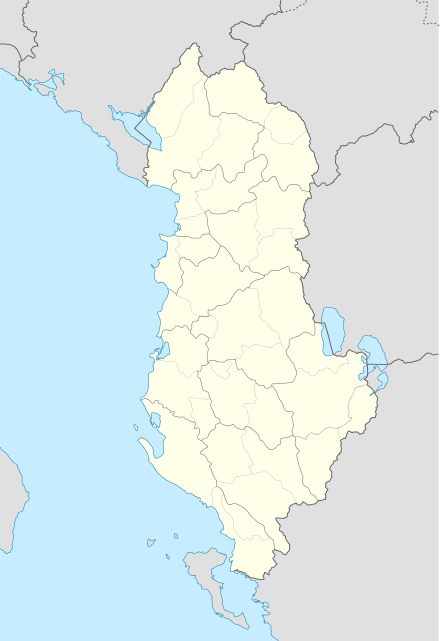Boriç i Madh
| Boriç i Madh | |
|---|---|
| Village | |
 Boriç i Madh | |
| Coordinates: 42°8′5″N 19°29′47″E / 42.13472°N 19.49639°ECoordinates: 42°8′5″N 19°29′47″E / 42.13472°N 19.49639°E | |
| Country |
|
| County | Shkodër |
| Municipality(s) | Malësi e Madhe |
| Time zone | UTC+1 (CET) |
| • Summer (DST) | UTC+2 (CEST) |
Boriç i Madh is a settlement in the former Gruemirë municipality, Shkodër County, northern Albania. At the 2015 local government reform it became part of the municipality Malësi e Madhe.[1] The village is inhabited by a majority of Slavic Muslims (using the demonym "Podgoričani"), and minorities of Albanians and Montenegrins, and is part of the wider Vraka region inhabited by Serbs–Montenegrins. The village is called Veliki Borič ("Big Borič") and Novi Borič ("New Borič") in Serbian.
Demographics
The Podgoričani (Slavic Muslims) hail from Montenegro, and number 86 families, while the Catholic Albanians number 20 families and the Orthodox Montenegrins 6 families (surnamed Popaj and Suto). The village had a total of ca. 950 inhabitants, out of which 700 were Muslims, 200 were Albanians and 50 were Serbs-Montenegrins (Orthodox from Montenegro). Prior to the 1960s, the village was inhabited only by the Slavic Muslims, however, the government organized and settled Catholics and Orthodox in the village. The most numerous of the Muslim families originate from known clans mostly hailing from Podgorica and its surroundings. These were muhajir (Muslim migrants) who left those areas after the Montenegrin liberation. The families were forced to change their surnames, thus, the Piranići are surnamed "Piranaj" and "Pirani", Pepić–Pepaj and Pepa, Lekić–Leka, Tuzović–Tuzi, Kerović–Keraj, Osmanagić–Osmani, Bibezić–Bibezi, Goković–Gokovi, Salagić–Salagaj, Ferizović–Ferizi, Beganović–Begani, etc.[2]
During the early 2010s linguists Klaus Steinke and Xhelal Ylli seeking to corroborate villages cited in past literature as being Slavic speaking carried out fieldwork in settlements of the area.[3] Boriç i Madh in the Shkodër area is one of a number of villages with a Slavophone population that speak a Montenegrin dialect.[3] One third of the population of Boriç i Madh is compact and composed of Muslim Podgoriçani.[4]
History
In 1989 the Boriç i Vogël quarter was detached from the Boriç village.[5] In 1995, during the Yugoslav Wars, there were incidents of violence against the Serb-Montenegrin minority in places like Boriç i Vogël and Boriç i Madh, where the Albanian government also tried to forcibly take land from them.[6] The Serb-Montenegrin minority in Shkodër and Malësia e Madhë claims to be treated unproperly.[7]
References
- ↑ Law nr. 115/2014
- ↑ Šćepanović 1991.
- 1 2 Steinke, Klaus; Ylli, Xhelal (2013). Die slavischen Minderheiten in Albanien (SMA). 4. Teil: Vraka - Borakaj. Munich: Verlag Otto Sagner. ISBN 9783866883635. p. 9. "Am östlichen Ufer des Shkodrasees gibt es heute auf dem Gebiet von Vraka vier Dörfer, in denen ein Teil der Bewohner eine montenegrinische Mundart spricht. Es handelt sich dabei um die Ortschaften Boriçi i Madh (Borić Veli), Boriçi i Vogël (Borić Mali/Borić Stari/Borić Vezirov), Gril (Grilj) und Omaraj (Omara), die verwaltungstechnisch Teil der Gemeinde Gruemira in der Region Malësia e Madhe sind. Ferner zählen zu dieser Gruppe noch die Dörfer Shtoji i Ri und Shtoji i Vjetër in der Gemeinde Rrethinat und weiter nordwestlich von Koplik das Dorf Kamica (Kamenica), das zur Gemeinde Qendër in der Region Malësia e Madhe gehört. Desgleichen wohnen vereinzelt in der Stadt sowie im Kreis Shkodra weitere Sprecher der montenegrinischen Mundart. Nach ihrer Konfession unterscheidet man zwei Gruppen, d.h. orthodoxe mid muslimische Slavophone. Die erste, kleinere Gruppe wohnt in Boriçi i Vogël, Gril, Omaraj und Kamica, die zweite, größere Gruppe in Boriçi i Madh und in Shtoj."
- ↑ Steinke & Ylli 2013, p. 103. "Boriçi i Madh - Borić Veli. Das Dorf besteht zu einem Drittel aus muslimischen Slavophonen. Zusammen mit Shtoj bildet Boriçi i Madh die größte kompakte Ansiedlung von den Podgoricanen in Vraka."
- ↑ "JPRS Report: East Europe" (81–90). United States Foreign Broadcast Information Service. 1989: 1.
- ↑ "FBIS Daily Report: East Europe" (136–146). United States Foreign Broadcast Information Service. 1995.
- ↑ "FBIS Daily Report: East Europe" (83–94). United States Foreign Broadcast Information Service. 1995: 2.
Sources
- Šćepanović, Slobodan (1991) [1990]. Најновији демографски и други подаци о Враки/Najnoviji demografski i drugi podaci o Vraki. Зборник радова са међународног научног скупа одржаног на Цетињу 21, 22. и 23. јуна 1990. године. Titograd: Историјски институт СР Црне Горе.
External links
- "Location of Boriç i Madh". Retrieved 26 August 2010.
